| Listing 1 - 10 of 18 | << page >> |
Sort by
|
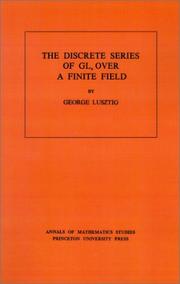
ISBN: 0691081549 1400881765 9780691081540 Year: 1974 Volume: 81 Publisher: Princeton : Princeton University Press,
Abstract | Keywords | Export | Availability | Bookmark
 Loading...
Loading...Choose an application
- Reference Manager
- EndNote
- RefWorks (Direct export to RefWorks)
In this book Professor Lusztig solves an interesting problem by entirely new methods: specifically, the use of cohomology of buildings and related complexes.The book gives an explicit construction of one distinguished member, D(V), of the discrete series of GLn (Fq), where V is the n-dimensional F-vector space on which GLn(Fq) acts. This is a p-adic representation; more precisely D(V) is a free module of rank (q--1) (q2-1)...(qn-1-1) over the ring of Witt vectors WF of F. In Chapter 1 the author studies the homology of partially ordered sets, and proves some vanishing theorems for the homology of some partially ordered sets associated to geometric structures. Chapter 2 is a study of the representation △ of the affine group over a finite field. In Chapter 3 D(V) is defined, and its restriction to parabolic subgroups is determined. In Chapter 4 the author computes the character of D(V), and shows how to obtain other members of the discrete series by applying Galois automorphisms to D(V). Applications are in Chapter 5. As one of the main applications of his study the author gives a precise analysis of a Brauer lifting of the standard representation of GLn(Fq).
Group theory --- Algebraic fields --- Linear algebraic groups --- Representations of groups --- Series --- 511.33 --- Algebra --- Mathematics --- Processes, Infinite --- Sequences (Mathematics) --- Group representation (Mathematics) --- Groups, Representation theory of --- Algebraic groups, Linear --- Geometry, Algebraic --- Algebraic varieties --- Algebraic number fields --- Algebraic numbers --- Fields, Algebraic --- Algebra, Abstract --- Algebraic number theory --- Rings (Algebra) --- Analytical and multiplicative number theory. Asymptotics. Sieves etc. --- Algebraic fields. --- Linear algebraic groups. --- Representations of groups. --- Series. --- 511.33 Analytical and multiplicative number theory. Asymptotics. Sieves etc. --- Analytical and multiplicative number theory. Asymptotics. Sieves etc --- Addition. --- Affine group. --- Automorphism. --- Dimension. --- Eigenvalues and eigenvectors. --- Endomorphism. --- Field of fractions. --- Finite field. --- Free module. --- Grothendieck group. --- Homomorphism. --- Linear subspace. --- Morphism. --- P-adic number. --- Partially ordered set. --- Simplicial complex. --- Tensor product. --- Theorem. --- Witt vector. --- Groupes algébriques linéaires --- Groupes algébriques linéaires --- Représentations de groupes
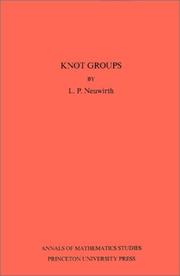
ISBN: 0691079919 1400882036 9780691079912 Year: 2016 Volume: 56 Publisher: Princeton, NJ : Princeton University Press,
Abstract | Keywords | Export | Availability | Bookmark
 Loading...
Loading...Choose an application
- Reference Manager
- EndNote
- RefWorks (Direct export to RefWorks)
The description for this book, Knot Groups. Annals of Mathematics Studies. (AM-56), Volume 56, will be forthcoming.
Topology --- 512 --- Algebra --- 512 Algebra --- Knot theory. --- Knots (Topology) --- Low-dimensional topology --- Abelian group. --- Alexander duality. --- Alexander polynomial. --- Algebraic theory. --- Algorithm. --- Analytic continuation. --- Associative property. --- Automorphism. --- Axiom. --- Bijection. --- Binary relation. --- Calculation. --- Central series. --- Characterization (mathematics). --- Cobordism. --- Coefficient. --- Cohomology. --- Combinatorics. --- Commutator subgroup. --- Complete theory. --- Computation. --- Conjugacy class. --- Conjugate element (field theory). --- Connected space. --- Connectedness. --- Coprime integers. --- Coset. --- Covering space. --- Curve. --- Cyclic group. --- Dehn's lemma. --- Determinant. --- Diagonalization. --- Diagram (category theory). --- Dimension. --- Direct product. --- Equivalence class. --- Equivalence relation. --- Euclidean space. --- Euler characteristic. --- Existential quantification. --- Fiber bundle. --- Finite group. --- Finitely generated module. --- Frattini subgroup. --- Free abelian group. --- Fundamental group. --- Geometry. --- Group ring. --- Group theory. --- Group with operators. --- Hausdorff space. --- Homeomorphism. --- Homology (mathematics). --- Homomorphism. --- Homotopy group. --- Homotopy. --- Identity matrix. --- Inner automorphism. --- Interior (topology). --- Intersection number (graph theory). --- Knot group. --- Linear combination. --- Manifold. --- Mathematical induction. --- Monomorphism. --- Morphism. --- Morse theory. --- Natural transformation. --- Non-abelian group. --- Normal subgroup. --- Orientability. --- Permutation. --- Polynomial. --- Presentation of a group. --- Principal ideal domain. --- Principal ideal. --- Root of unity. --- Semigroup. --- Simplicial complex. --- Simply connected space. --- Special case. --- Square matrix. --- Subgroup. --- Subset. --- Summation. --- Theorem. --- Three-dimensional space (mathematics). --- Topological space. --- Topology. --- Torus knot. --- Transfinite number. --- Trefoil knot. --- Trichotomy (mathematics). --- Trivial group. --- Triviality (mathematics). --- Two-dimensional space. --- Unit vector. --- Wreath product.
Book
ISBN: 0691080917 1400881781 9780691080918 Year: 1971 Volume: 68 Publisher: Princeton : Princeton University Press,
Abstract | Keywords | Export | Availability | Bookmark
 Loading...
Loading...Choose an application
- Reference Manager
- EndNote
- RefWorks (Direct export to RefWorks)
Part exposition and part presentation of new results, this monograph deals with that area of mathematics which has both combinatorial group theory and mathematical logic in common. Its main topics are the word problem for groups, the conjugacy problem for groups, and the isomorphism problem for groups. The presentation depends on previous results of J. L. Britton, which, with other factual background, are treated in detail.
Group theory --- 510.6 --- Mathematical logic --- 510.6 Mathematical logic --- Group theory. --- Logic, Symbolic and mathematical. --- Groupes, Théorie des --- Groups, Theory of --- Substitutions (Mathematics) --- Algebra --- Algebra of logic --- Logic, Universal --- Symbolic and mathematical logic --- Symbolic logic --- Mathematics --- Algebra, Abstract --- Metamathematics --- Set theory --- Syllogism --- Abelian group. --- Betti number. --- Characteristic function (probability theory). --- Characterization (mathematics). --- Combinatorial group theory. --- Conjecture. --- Conjugacy class. --- Conjugacy problem. --- Contradiction. --- Corollary. --- Cyclic permutation. --- Decision problem. --- Diffeomorphism. --- Direct product. --- Direct proof. --- Effective method. --- Elementary class. --- Embedding. --- Enumeration. --- Epimorphism. --- Equation. --- Equivalence relation. --- Exact sequence. --- Existential quantification. --- Finite group. --- Finite set. --- Finitely generated group. --- Finitely presented. --- Free group. --- Free product. --- Fundamental group. --- Fundamental theorem. --- Group (mathematics). --- Gödel numbering. --- Homomorphism. --- Homotopy. --- Inner automorphism. --- Markov property. --- Mathematical logic. --- Mathematical proof. --- Mathematics. --- Monograph. --- Natural number. --- Nilpotent group. --- Normal subgroup. --- Notation. --- Permutation. --- Polycyclic group. --- Presentation of a group. --- Quotient group. --- Recursive set. --- Requirement. --- Residually finite group. --- Semigroup. --- Simple set. --- Simplicial complex. --- Solvable group. --- Statistical hypothesis testing. --- Subgroup. --- Theorem. --- Theory. --- Topology. --- Transitive relation. --- Triviality (mathematics). --- Truth table. --- Turing degree. --- Turing machine. --- Without loss of generality. --- Word problem (mathematics). --- Groupes, Théorie des --- Décidabilité (logique mathématique)
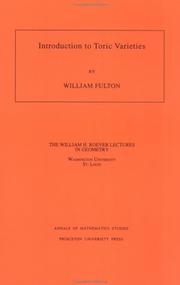
ISBN: 0691000492 0691033323 1400882524 Year: 1993 Publisher: Princeton Princeton university press
Abstract | Keywords | Export | Availability | Bookmark
 Loading...
Loading...Choose an application
- Reference Manager
- EndNote
- RefWorks (Direct export to RefWorks)
Toric varieties are algebraic varieties arising from elementary geometric and combinatorial objects such as convex polytopes in Euclidean space with vertices on lattice points. Since many algebraic geometry notions such as singularities, birational maps, cycles, homology, intersection theory, and Riemann-Roch translate into simple facts about polytopes, toric varieties provide a marvelous source of examples in algebraic geometry. In the other direction, general facts from algebraic geometry have implications for such polytopes, such as to the problem of the number of lattice points they contain. In spite of the fact that toric varieties are very special in the spectrum of all algebraic varieties, they provide a remarkably useful testing ground for general theories. The aim of this mini-course is to develop the foundations of the study of toric varieties, with examples, and describe some of these relations and applications. The text concludes with Stanley's theorem characterizing the numbers of simplicies in each dimension in a convex simplicial polytope. Although some general theorems are "ed without proof, the concrete interpretations via simplicial geometry should make the text accessible to beginners in algebraic geometry.
Algebraic geometry --- Differential geometry. Global analysis --- 512.7 --- Algebraic geometry. Commutative rings and algebras --- Toric varieties. --- 512.7 Algebraic geometry. Commutative rings and algebras --- Toric varieties --- Embeddings, Torus --- Torus embeddings --- Varieties, Toric --- Algebraic varieties --- Addition. --- Affine plane. --- Affine space. --- Affine variety. --- Alexander Grothendieck. --- Alexander duality. --- Algebraic curve. --- Algebraic group. --- Atiyah–Singer index theorem. --- Automorphism. --- Betti number. --- Big O notation. --- Characteristic class. --- Chern class. --- Chow group. --- Codimension. --- Cohomology. --- Combinatorics. --- Commutative property. --- Complete intersection. --- Convex polytope. --- Convex set. --- Coprime integers. --- Cotangent space. --- Dedekind sum. --- Dimension (vector space). --- Dimension. --- Direct proof. --- Discrete valuation ring. --- Discrete valuation. --- Disjoint union. --- Divisor (algebraic geometry). --- Divisor. --- Dual basis. --- Dual space. --- Equation. --- Equivalence class. --- Equivariant K-theory. --- Euler characteristic. --- Exact sequence. --- Explicit formula. --- Facet (geometry). --- Fundamental group. --- Graded ring. --- Grassmannian. --- H-vector. --- Hirzebruch surface. --- Hodge theory. --- Homogeneous coordinates. --- Homomorphism. --- Hypersurface. --- Intersection theory. --- Invertible matrix. --- Invertible sheaf. --- Isoperimetric inequality. --- Lattice (group). --- Leray spectral sequence. --- Limit point. --- Line bundle. --- Line segment. --- Linear subspace. --- Local ring. --- Mathematical induction. --- Mixed volume. --- Moduli space. --- Moment map. --- Monotonic function. --- Natural number. --- Newton polygon. --- Open set. --- Picard group. --- Pick's theorem. --- Polytope. --- Projective space. --- Quadric. --- Quotient space (topology). --- Regular sequence. --- Relative interior. --- Resolution of singularities. --- Restriction (mathematics). --- Resultant. --- Riemann–Roch theorem. --- Serre duality. --- Sign (mathematics). --- Simplex. --- Simplicial complex. --- Simultaneous equations. --- Spectral sequence. --- Subgroup. --- Subset. --- Summation. --- Surjective function. --- Tangent bundle. --- Theorem. --- Topology. --- Toric variety. --- Unit disk. --- Vector space. --- Weil conjecture. --- Zariski topology.
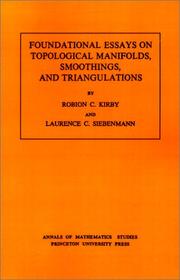
ISBN: 0691081905 0691081913 1400881501 9780691081908 Year: 1977 Volume: no. 88 Publisher: Princeton : Tokyo : Princeton University Press University of Tokyo press,
Abstract | Keywords | Export | Availability | Bookmark
 Loading...
Loading...Choose an application
- Reference Manager
- EndNote
- RefWorks (Direct export to RefWorks)
Since Poincaré's time, topologists have been most concerned with three species of manifold. The most primitive of these--the TOP manifolds--remained rather mysterious until 1968, when Kirby discovered his now famous torus unfurling device. A period of rapid progress with TOP manifolds ensued, including, in 1969, Siebenmann's refutation of the Hauptvermutung and the Triangulation Conjecture. Here is the first connected account of Kirby's and Siebenmann's basic research in this area.The five sections of this book are introduced by three articles by the authors that initially appeared between 1968 and 1970. Appendices provide a full discussion of the classification of homotopy tori, including Casson's unpublished work and a consideration of periodicity in topological surgery.
Differential geometry. Global analysis --- Manifolds (Mathematics) --- Piecewise linear topology --- Triangulating manifolds --- Variétés (Mathématiques) --- Topologie linéaire par morceaux --- 515.16 --- Manifolds, Triangulating --- PL topology --- Topology --- Geometry, Differential --- Topology of manifolds --- Piecewise linear topology. --- Triangulating manifolds. --- Manifolds (Mathematics). --- 515.16 Topology of manifolds --- Variétés (Mathématiques) --- Topologie linéaire par morceaux --- Triangulation. --- Triangulation --- Affine space. --- Algebraic topology (object). --- Approximation. --- Associative property. --- Automorphism. --- Big O notation. --- CW complex. --- Calculation. --- Cap product. --- Cartesian product. --- Category of sets. --- Chain complex. --- Classification theorem. --- Classifying space. --- Cobordism. --- Codimension. --- Cofibration. --- Cohomology. --- Connected space. --- Continuous function (set theory). --- Continuous function. --- Counterexample. --- Diffeomorphism. --- Differentiable manifold. --- Differential structure. --- Differential topology. --- Dimension (vector space). --- Direct proof. --- Disjoint union. --- Elementary proof. --- Embedding. --- Euclidean space. --- Existence theorem. --- Existential quantification. --- Fiber bundle. --- Fibration. --- General position. --- Geometry. --- Group homomorphism. --- H-cobordism. --- H-space. --- Handle decomposition. --- Handlebody. --- Hauptvermutung. --- Hausdorff space. --- Hilbert cube. --- Homeomorphism group. --- Homeomorphism. --- Homomorphism. --- Homotopy group. --- Homotopy. --- Inclusion map. --- Injective function. --- Invertible matrix. --- K-cell (mathematics). --- Kan extension. --- Linear subspace. --- Linear topology. --- Manifold. --- Mapping cylinder. --- Mathematical induction. --- Mathematician. --- Metric space. --- Morse theory. --- Neighbourhood (mathematics). --- Open set. --- Partition of unity. --- Piecewise linear manifold. --- Piecewise linear. --- Poincaré conjecture. --- Polyhedron. --- Principal bundle. --- Product metric. --- Pushout (category theory). --- Regular homotopy. --- Retract. --- Sheaf (mathematics). --- Simplicial complex. --- Smoothing. --- Spin structure. --- Stability theory. --- Stable manifold. --- Standard map. --- Submanifold. --- Submersion (mathematics). --- Subset. --- Surgery exact sequence. --- Surjective function. --- Theorem. --- Topological group. --- Topological manifold. --- Topological space. --- Topology. --- Transversal (geometry). --- Transversality (mathematics). --- Transversality theorem. --- Union (set theory). --- Uniqueness theorem. --- Vector bundle. --- Zorn's lemma. --- Variétés topologiques
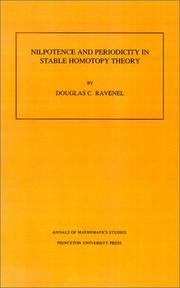
ISBN: 069108792X 069102572X 1400882486 9780691025728 9780691087924 Year: 2016 Volume: 128 Publisher: Princeton, NJ : Princeton University Press,
Abstract | Keywords | Export | Availability | Bookmark
 Loading...
Loading...Choose an application
- Reference Manager
- EndNote
- RefWorks (Direct export to RefWorks)
Nilpotence and Periodicity in Stable Homotopy Theory describes some major advances made in algebraic topology in recent years, centering on the nilpotence and periodicity theorems, which were conjectured by the author in 1977 and proved by Devinatz, Hopkins, and Smith in 1985. During the last ten years a number of significant advances have been made in homotopy theory, and this book fills a real need for an up-to-date text on that topic. Ravenel's first few chapters are written with a general mathematical audience in mind. They survey both the ideas that lead up to the theorems and their applications to homotopy theory. The book begins with some elementary concepts of homotopy theory that are needed to state the problem. This includes such notions as homotopy, homotopy equivalence, CW-complex, and suspension. Next the machinery of complex cobordism, Morava K-theory, and formal group laws in characteristic p are introduced. The latter portion of the book provides specialists with a coherent and rigorous account of the proofs. It includes hitherto unpublished material on the smash product and chromatic convergence theorems and on modular representations of the symmetric group.
Homotopie --- Homotopy theory --- Homotopy theory. --- Deformations, Continuous --- Topology --- Abelian category. --- Abelian group. --- Adams spectral sequence. --- Additive category. --- Affine space. --- Algebra homomorphism. --- Algebraic closure. --- Algebraic structure. --- Algebraic topology (object). --- Algebraic topology. --- Algebraic variety. --- Algebraically closed field. --- Atiyah–Hirzebruch spectral sequence. --- Automorphism. --- Boolean algebra (structure). --- CW complex. --- Canonical map. --- Cantor set. --- Category of topological spaces. --- Category theory. --- Classification theorem. --- Classifying space. --- Cohomology operation. --- Cohomology. --- Cokernel. --- Commutative algebra. --- Commutative ring. --- Complex projective space. --- Complex vector bundle. --- Computation. --- Conjecture. --- Conjugacy class. --- Continuous function. --- Contractible space. --- Coproduct. --- Differentiable manifold. --- Disjoint union. --- Division algebra. --- Equation. --- Explicit formulae (L-function). --- Functor. --- G-module. --- Groupoid. --- Homology (mathematics). --- Homomorphism. --- Homotopy category. --- Homotopy group. --- Homotopy. --- Hopf algebra. --- Hurewicz theorem. --- Inclusion map. --- Infinite product. --- Integer. --- Inverse limit. --- Irreducible representation. --- Isomorphism class. --- K-theory. --- Loop space. --- Mapping cone (homological algebra). --- Mathematical induction. --- Modular representation theory. --- Module (mathematics). --- Monomorphism. --- Moore space. --- Morava K-theory. --- Morphism. --- N-sphere. --- Noetherian ring. --- Noetherian. --- Noncommutative ring. --- Number theory. --- P-adic number. --- Piecewise linear manifold. --- Polynomial ring. --- Polynomial. --- Power series. --- Prime number. --- Principal ideal domain. --- Profinite group. --- Reduced homology. --- Ring (mathematics). --- Ring homomorphism. --- Ring spectrum. --- Simplicial complex. --- Simply connected space. --- Smash product. --- Special case. --- Spectral sequence. --- Steenrod algebra. --- Sub"ient. --- Subalgebra. --- Subcategory. --- Subring. --- Symmetric group. --- Tensor product. --- Theorem. --- Topological space. --- Topology. --- Vector bundle. --- Zariski topology.
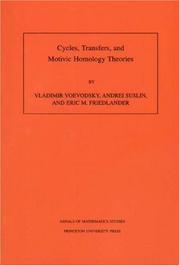
ISBN: 0691048142 0691048150 9786613379825 1283379821 140083712X 9780691048147 9780691048154 Year: 2011 Volume: 143 Publisher: Princeton, NJ : Princeton University Press,
Abstract | Keywords | Export | Availability | Bookmark
 Loading...
Loading...Choose an application
- Reference Manager
- EndNote
- RefWorks (Direct export to RefWorks)
The original goal that ultimately led to this volume was the construction of "motivic cohomology theory," whose existence was conjectured by A. Beilinson and S. Lichtenbaum. This is achieved in the book's fourth paper, using results of the other papers whose additional role is to contribute to our understanding of various properties of algebraic cycles. The material presented provides the foundations for the recent proof of the celebrated "Milnor Conjecture" by Vladimir Voevodsky. The theory of sheaves of relative cycles is developed in the first paper of this volume. The theory of presheaves with transfers and more specifically homotopy invariant presheaves with transfers is the main theme of the second paper. The Friedlander-Lawson moving lemma for families of algebraic cycles appears in the third paper in which a bivariant theory called bivariant cycle cohomology is constructed. The fifth and last paper in the volume gives a proof of the fact that bivariant cycle cohomology groups are canonically isomorphic (in appropriate cases) to Bloch's higher Chow groups, thereby providing a link between the authors' theory and Bloch's original approach to motivic (co-)homology.
Bundeltheorie --- Cohomology [Sheaf ] --- Faisceaux [Théorie des ] --- Sheaf cohomology --- Sheaf theory --- Sheaves (Algebraic topology) --- Sheaves [Theory of ] --- Théorie des faisceaux --- Algebraic cycles --- Homology theory --- Algebraic cycles. --- Homology theory. --- Cohomology theory --- Contrahomology theory --- Algebraic topology --- Cycles, Algebraic --- Geometry, Algebraic --- Abelian category. --- Abelian group. --- Addition. --- Additive category. --- Adjoint functors. --- Affine space. --- Affine variety. --- Alexander Grothendieck. --- Algebraic K-theory. --- Algebraic cycle. --- Algebraically closed field. --- Andrei Suslin. --- Associative property. --- Base change. --- Category of abelian groups. --- Chain complex. --- Chow group. --- Closed immersion. --- Codimension. --- Coefficient. --- Cohomology. --- Cokernel. --- Commutative property. --- Commutative ring. --- Compactification (mathematics). --- Comparison theorem. --- Computation. --- Connected component (graph theory). --- Connected space. --- Corollary. --- Diagram (category theory). --- Dimension. --- Discrete valuation ring. --- Disjoint union. --- Divisor. --- Embedding. --- Endomorphism. --- Epimorphism. --- Exact sequence. --- Existential quantification. --- Field of fractions. --- Functor. --- Generic point. --- Geometry. --- Grothendieck topology. --- Homeomorphism. --- Homogeneous coordinates. --- Homology (mathematics). --- Homomorphism. --- Homotopy category. --- Homotopy. --- Injective sheaf. --- Irreducible component. --- K-theory. --- Mathematical induction. --- Mayer–Vietoris sequence. --- Milnor K-theory. --- Monoid. --- Monoidal category. --- Monomorphism. --- Morphism of schemes. --- Morphism. --- Motivic cohomology. --- Natural transformation. --- Nisnevich topology. --- Noetherian. --- Open set. --- Pairing. --- Perfect field. --- Permutation. --- Picard group. --- Presheaf (category theory). --- Projective space. --- Projective variety. --- Proper morphism. --- Quasi-projective variety. --- Residue field. --- Resolution of singularities. --- Scientific notation. --- Sheaf (mathematics). --- Simplicial complex. --- Simplicial set. --- Singular homology. --- Smooth scheme. --- Spectral sequence. --- Subcategory. --- Subgroup. --- Summation. --- Support (mathematics). --- Tensor product. --- Theorem. --- Topology. --- Triangulated category. --- Type theory. --- Universal coefficient theorem. --- Variable (mathematics). --- Vector bundle. --- Vladimir Voevodsky. --- Zariski topology. --- Zariski's main theorem. --- 512.73 --- 512.73 Cohomology theory of algebraic varieties and schemes --- Cohomology theory of algebraic varieties and schemes
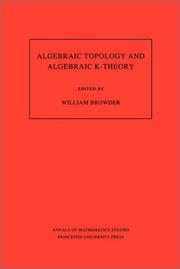
ISBN: 0691084157 0691084262 1400882117 Year: 1987 Publisher: Princeton : Princeton University Press,
Abstract | Keywords | Export | Availability | Bookmark
 Loading...
Loading...Choose an application
- Reference Manager
- EndNote
- RefWorks (Direct export to RefWorks)
This book contains accounts of talks held at a symposium in honorof John C. Moore in October 1983 at Princeton University, The workincludes papers in classical homotopy theory, homological algebra,rational homotopy theory, algebraic K-theory of spaces, and othersubjects.
Algebraic topology --- K-theory --- 512.73 --- 515.14 --- 512.73 Cohomology theory of algebraic varieties and schemes --- Cohomology theory of algebraic varieties and schemes --- 515.14 Algebraic topology --- Moore, John C. --- Abelian group. --- Adams spectral sequence. --- Adjoint functors. --- Adjunction (field theory). --- Algebraic K-theory. --- Algebraic closure. --- Algebraic geometry. --- Algebraic group. --- Algebraic number field. --- Algebraic space. --- Algebraic topology. --- Algebraically closed field. --- Associative algebra. --- Boundary (topology). --- CW complex. --- Classification theorem. --- Closure (mathematics). --- Coalgebra. --- Cofibration. --- Cohomology. --- Commutative diagram. --- Commutative property. --- Coproduct. --- Deformation theory. --- Degenerate bilinear form. --- Diagram (category theory). --- Differentiable manifold. --- Dimension (vector space). --- Division algebra. --- Eilenberg–Moore spectral sequence. --- Epimorphism. --- Exterior (topology). --- Formal power series. --- Free Lie algebra. --- Free algebra. --- Freudenthal suspension theorem. --- Function (mathematics). --- Function space. --- Functor. --- G-module. --- Galois extension. --- Global dimension. --- Group cohomology. --- Group homomorphism. --- H-space. --- Hilbert's Theorem 90. --- Homology (mathematics). --- Homomorphism. --- Homotopy category. --- Homotopy group. --- Homotopy. --- Hopf algebra. --- Hopf invariant. --- Hurewicz theorem. --- Inclusion map. --- Inequality (mathematics). --- Integral domain. --- Isometry. --- Isomorphism class. --- K-theory. --- Lie algebra. --- Lie group. --- Limit (category theory). --- Loop space. --- Mathematician. --- Mathematics. --- Noetherian ring. --- Order topology. --- P-adic number. --- Polynomial ring. --- Polynomial. --- Prime number. --- Principal bundle. --- Principal ideal domain. --- Projective module. --- Projective plane. --- Pullback (category theory). --- Pushout (category theory). --- Ring of integers. --- Series (mathematics). --- Sheaf (mathematics). --- Simplicial category. --- Simplicial complex. --- Simplicial set. --- Special case. --- Spectral sequence. --- Square (algebra). --- Stable homotopy theory. --- Steenrod algebra. --- Superalgebra. --- Theorem. --- Topological K-theory. --- Topological space. --- Topology. --- Triviality (mathematics). --- Uniqueness theorem. --- Universal enveloping algebra. --- Vector bundle. --- Weak equivalence (homotopy theory). --- William Browder (mathematician). --- Géométrie algébrique --- K-théorie
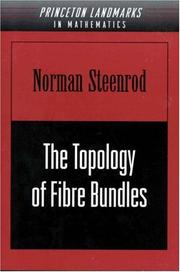
ISBN: 0691080550 0691005486 1400883873 9780691080550 Year: 1951 Volume: 14 Publisher: Princeton (N.J.): Princeton university press
Abstract | Keywords | Export | Availability | Bookmark
 Loading...
Loading...Choose an application
- Reference Manager
- EndNote
- RefWorks (Direct export to RefWorks)
Fibre bundles, now an integral part of differential geometry, are also of great importance in modern physics--such as in gauge theory. This book, a succinct introduction to the subject by renown mathematician Norman Steenrod, was the first to present the subject systematically. It begins with a general introduction to bundles, including such topics as differentiable manifolds and covering spaces. The author then provides brief surveys of advanced topics, such as homotopy theory and cohomology theory, before using them to study further properties of fibre bundles. The result is a classic and timeless work of great utility that will appeal to serious mathematicians and theoretical physicists alike.
#WWIS:d.d. Prof. L. Bouckaert/ALTO --- 515.1 --- 515.1 Topology --- Topology --- Topology. --- Analysis situs --- Position analysis --- Rubber-sheet geometry --- Geometry --- Polyhedra --- Set theory --- Algebras, Linear --- Algebraic topology. --- Associated bundle. --- Associative algebra. --- Associative property. --- Atlas (topology). --- Automorphism. --- Axiomatic system. --- Barycentric subdivision. --- Bilinear map. --- Bundle map. --- Classification theorem. --- Coefficient. --- Cohomology ring. --- Cohomology. --- Conjugacy class. --- Connected component (graph theory). --- Connected space. --- Coordinate system. --- Coset. --- Cup product. --- Cyclic group. --- Determinant. --- Differentiable manifold. --- Differential structure. --- Dimension (vector space). --- Direct product. --- Division algebra. --- Equivalence class. --- Equivalence relation. --- Euler number. --- Existence theorem. --- Existential quantification. --- Factorization. --- Fiber bundle. --- Frenet–Serret formulas. --- Gram–Schmidt process. --- Group theory. --- Homeomorphism. --- Homology (mathematics). --- Homomorphism. --- Homotopy group. --- Homotopy. --- Hopf theorem. --- Hurewicz theorem. --- Identity element. --- Inclusion map. --- Inner automorphism. --- Invariant subspace. --- Invertible matrix. --- Jacobian matrix and determinant. --- Klein bottle. --- Lattice of subgroups. --- Lie group. --- Line element. --- Line segment. --- Linear map. --- Linear space (geometry). --- Linear subspace. --- Manifold. --- Mapping cylinder. --- Metric tensor. --- N-sphere. --- Natural topology. --- Octonion. --- Open set. --- Orientability. --- Orthogonal group. --- Orthogonalization. --- Permutation. --- Principal bundle. --- Product topology. --- Quadratic form. --- Quaternion. --- Retract. --- Separable space. --- Set theory. --- Simplicial complex. --- Special case. --- Stiefel manifold. --- Subalgebra. --- Subbase. --- Subgroup. --- Subset. --- Symmetric tensor. --- Tangent bundle. --- Tangent space. --- Tangent vector. --- Tensor field. --- Tensor. --- Theorem. --- Tietze extension theorem. --- Topological group. --- Topological space. --- Transitive relation. --- Transpose. --- Union (set theory). --- Unit sphere. --- Universal bundle. --- Vector field.
Book
ISBN: 1283227436 9786613227430 1400839041 9781400839049 9781283227438 9780691147949 0691147949 Year: 2011 Publisher: Princeton, NJ
Abstract | Keywords | Export | Availability | Bookmark
 Loading...
Loading...Choose an application
- Reference Manager
- EndNote
- RefWorks (Direct export to RefWorks)
"The study of the mapping class group Mod(S) is a classical topic that is experiencing a renaissance. It lies at the juncture of geometry, topology, and group theory. This book explains as many important theorems, examples, and techniques as possible, quickly and directly, while at the same time giving full details and keeping the text nearly self-contained. The book is suitable for graduate students.The book begins by explaining the main group-theoretical properties of Mod(S), from finite generation by Dehn twists and low-dimensional homology to the Dehn-Nielsen-Baer theorem. Along the way, central objects and tools are introduced, such as the Birman exact sequence, the complex of curves, the braid group, the symplectic representation, and the Torelli group. The book then introduces Teichm©oller space and its geometry, and uses the action of Mod(S) on it to prove the Nielsen-Thurston classification of surface homeomorphisms. Topics include the topology of the moduli space of Riemann surfaces, the connection with surface bundles, pseudo-Anosov theory, and Thurston's approach to the classification"--Provided by publisher.
Mappings (Mathematics) --- Class groups (Mathematics) --- Groups, Class (Mathematics) --- Algebraic number theory --- Commutative rings --- Ideals (Algebra) --- Maps (Mathematics) --- Functions --- Functions, Continuous --- Topology --- Transformations (Mathematics) --- 3-manifold theory. --- Alexander method. --- Birman exact sequence. --- BirmanЈilden theorem. --- Dehn twists. --- DehnЌickorish theorem. --- DehnЎielsenЂaer theorem. --- Dennis Johnson. --- Euler class. --- FenchelЎielsen coordinates. --- Gervais presentation. --- Grtzsch's problem. --- Johnson homomorphism. --- Markov partitions. --- Meyer signature cocycle. --- Mod(S). --- Nielsen realization theorem. --- NielsenДhurston classification theorem. --- NielsenДhurston classification. --- Riemann surface. --- Teichmller mapping. --- Teichmller metric. --- Teichmller space. --- Thurston compactification. --- Torelli group. --- Wajnryb presentation. --- algebraic integers. --- algebraic intersection number. --- algebraic relations. --- algebraic structure. --- annulus. --- aspherical manifold. --- bigon criterion. --- braid group. --- branched cover. --- capping homomorphism. --- classifying space. --- closed surface. --- collar lemma. --- compactness criterion. --- complex of curves. --- configuration space. --- conjugacy class. --- coordinates principle. --- cutting homomorphism. --- cyclic subgroup. --- diffeomorphism. --- disk. --- existence theorem. --- extended mapping class group. --- finite index. --- finite subgroup. --- finite-order homeomorphism. --- finite-order mapping class. --- first homology group. --- geodesic laminations. --- geometric classification. --- geometric group theory. --- geometric intersection number. --- geometric operation. --- geometry. --- harmonic maps. --- holomorphic quadratic differential. --- homeomorphism. --- homological criterion. --- homotopy. --- hyperbolic geometry. --- hyperbolic plane. --- hyperbolic structure. --- hyperbolic surface. --- inclusion homomorphism. --- infinity. --- intersection number. --- isotopy. --- lantern relation. --- low-dimensional homology. --- mapping class group. --- mapping torus. --- measured foliation space. --- measured foliations. --- metric geometry. --- moduli space. --- orbifold. --- orbit. --- outer automorphism group. --- pseudo-Anosov homeomorphism. --- punctured disk. --- quasi-isometry. --- quasiconformal map. --- second homology group. --- simple closed curve. --- simplicial complex. --- stretch factors. --- surface bundles. --- surface homeomorphism. --- surface. --- symplectic representation. --- topology. --- torsion. --- torus. --- train track.
| Listing 1 - 10 of 18 | << page >> |
Sort by
|

 Search
Search Feedback
Feedback About UniCat
About UniCat  Help
Help News
News